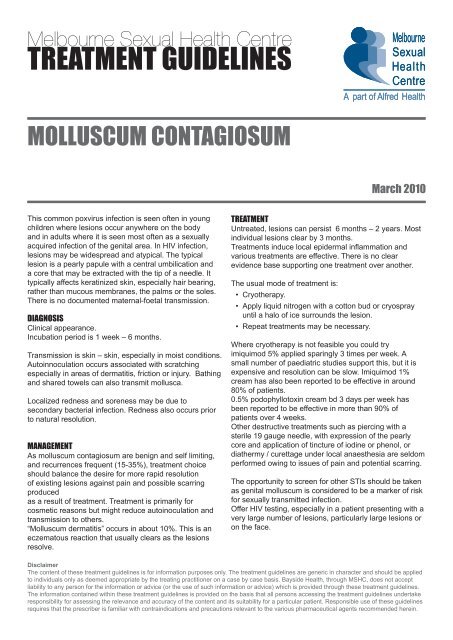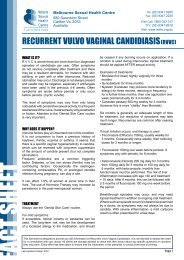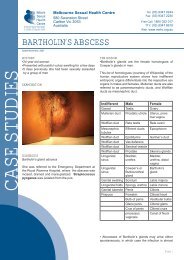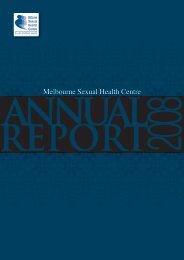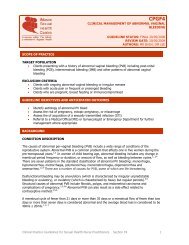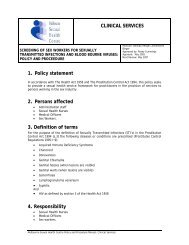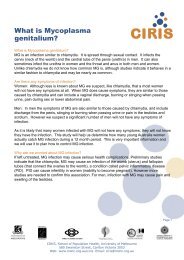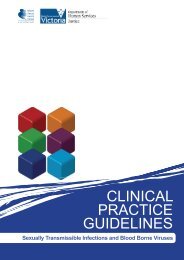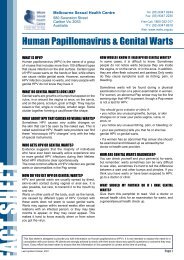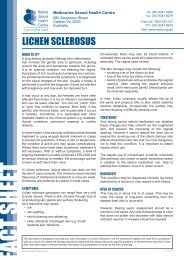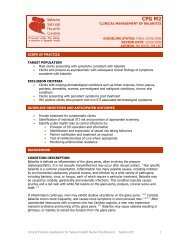TREATMENT GUIDELINES - Melbourne Sexual Health Centre
TREATMENT GUIDELINES - Melbourne Sexual Health Centre
TREATMENT GUIDELINES - Melbourne Sexual Health Centre
You also want an ePaper? Increase the reach of your titles
YUMPU automatically turns print PDFs into web optimized ePapers that Google loves.
<strong>Melbourne</strong> <strong>Sexual</strong> <strong>Health</strong> <strong>Centre</strong><br />
<strong>TREATMENT</strong> <strong>GUIDELINES</strong><br />
<strong>Melbourne</strong><br />
<strong>Sexual</strong><br />
<strong>Health</strong><br />
<strong>Centre</strong><br />
A part of Alfred <strong>Health</strong><br />
MOLLUSCUM CONTAGIOSUM<br />
March 2010<br />
This common poxvirus infection is seen often in young<br />
children where lesions occur anywhere on the body<br />
and in adults where it is seen most often as a sexually<br />
acquired infection of the genital area. In HIV infection,<br />
lesions may be widespread and atypical. The typical<br />
lesion is a pearly papule with a central umbilication and<br />
a core that may be extracted with the tip of a needle. It<br />
typically affects keratinized skin, especially hair bearing,<br />
rather than mucous membranes, the palms or the soles.<br />
There is no documented maternal-foetal transmission.<br />
DIAGNOSIS<br />
Clinical appearance.<br />
Incubation period is 1 week – 6 months.<br />
Transmission is skin – skin, especially in moist conditions.<br />
Autoinnoculation occurs associated with scratching<br />
especially in areas of dermatitis, friction or injury. Bathing<br />
and shared towels can also transmit mollusca.<br />
Localized redness and soreness may be due to<br />
secondary bacterial infection. Redness also occurs prior<br />
to natural resolution.<br />
MANAGEMENT<br />
As molluscum contagiosum are benign and self limiting,<br />
and recurrences frequent (15-35%), treatment choice<br />
should balance the desire for more rapid resolution<br />
of existing lesions against pain and possible scarring<br />
produced<br />
as a result of treatment. Treatment is primarily for<br />
cosmetic reasons but might reduce autoinoculation and<br />
transmission to others.<br />
“Molluscum dermatitis” occurs in about 10%. This is an<br />
eczematous reaction that usually clears as the lesions<br />
resolve.<br />
<strong>TREATMENT</strong><br />
Untreated, lesions can persist 6 months – 2 years. Most<br />
individual lesions clear by 3 months.<br />
Treatments induce local epidermal inflammation and<br />
various treatments are effective. There is no clear<br />
evidence base supporting one treatment over another.<br />
The usual mode of treatment is:<br />
• Cryotherapy.<br />
• Apply liquid nitrogen with a cotton bud or cryospray<br />
until a halo of ice surrounds the lesion.<br />
• Repeat treatments may be necessary.<br />
Where cryotherapy is not feasible you could try<br />
imiquimod 5% applied sparingly 3 times per week. A<br />
small number of paediatric studies support this, but it is<br />
expensive and resolution can be slow. Imiquimod 1%<br />
cream has also been reported to be effective in around<br />
80% of patients.<br />
0.5% podophyllotoxin cream bd 3 days per week has<br />
been reported to be effective in more than 90% of<br />
patients over 4 weeks.<br />
Other destructive treatments such as piercing with a<br />
sterile 19 gauge needle, with expression of the pearly<br />
core and application of tincture of iodine or phenol, or<br />
diathermy / curettage under local anaesthesia are seldom<br />
performed owing to issues of pain and potential scarring.<br />
The opportunity to screen for other STIs should be taken<br />
as genital molluscum is considered to be a marker of risk<br />
for sexually transmitted infection.<br />
Offer HIV testing, especially in a patient presenting with a<br />
very large number of lesions, particularly large lesions or<br />
on the face.<br />
Disclaimer<br />
The content of these treatment guidelines is for information purposes only. The treatment guidelines are generic in character and should be applied<br />
to individuals only as deemed appropriate by the treating practitioner on a case by case basis. Bayside <strong>Health</strong>, through MSHC, does not accept<br />
liability to any person for the information or advice (or the use of such information or advice) which is provided through these treatment guidelines.<br />
The information contained within these treatment guidelines is provided on the basis that all persons accessing the treatment guidelines undertake<br />
responsibility for assessing the relevance and accuracy of the content and its suitability for a particular patient. Responsible use of these guidelines<br />
requires that the prescriber is familiar with contraindications and precautions relevant to the various pharmaceutical agents recommended herein.
<strong>Melbourne</strong> <strong>Sexual</strong> <strong>Health</strong> <strong>Centre</strong><br />
<strong>TREATMENT</strong> <strong>GUIDELINES</strong><br />
<strong>Melbourne</strong><br />
<strong>Sexual</strong><br />
<strong>Health</strong><br />
<strong>Centre</strong><br />
A part of Alfred <strong>Health</strong><br />
MOLLUSCUM CONTAGIOSUM<br />
March 2010<br />
References.<br />
King Holmes <strong>Sexual</strong>ly Transmitted Diseases 4th Edition.<br />
2008.<br />
Van der Wouden JC, and others. Interventions for<br />
cutaneous molluscum contagiousum. Cochrane<br />
Database Syst Rev 2009 Oct 7; (4):CD004767.<br />
Syed TA, Lundin S, Ahmad M. Dermatology.<br />
1994;189(1):65-68.<br />
Syed TA, and others. Treatment of molluscum<br />
contagiousum in males with an analogue of imiquimod<br />
1% in cream: a placebo-controlled, double-blind study. J<br />
Dermatol. 1998 May;25(5):309-13.


